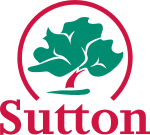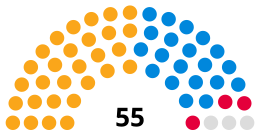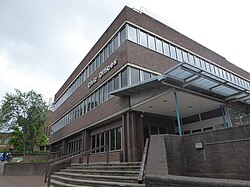Sutton London Borough Council | |
|---|---|
 Coat of arms | |
 Council logo | |
| Type | |
| Type | |
| Leadership | |
Helen Bailey since 2019[2] | |
| Structure | |
| Seats | 54 councillors |
 | |
Political groups |
|
| Elections | |
| Plurality-at-large | |
Last election | 5 May 2022 |
Next election | 7 May 2026 |
| Meeting place | |
 | |
| Civic Offices, St Nicholas Way, Sutton, SM1 1EA | |
| Website | |
| www | |
Sutton London Borough Council, also known as Sutton Council, is the local authority for the London Borough of Sutton in Greater London, England. It is a London borough council, one of 32 in London. The council has been under Liberal Democrat majority control since 1990. The council is based at the Civic Offices in Sutton.
History
The parish of Sutton had been made a local government district in 1882.[3] The neighbouring parish of Carshalton was made a local government district the following year.[4] Such districts were reconstituted as urban districts under the Local Government Act 1894. Another urban district was created in 1915 covering the two parishes of Beddington and Wallington.[5]
The Sutton Urban District was enlarged in 1928 to take in the neighbouring parish of Cheam, at which point the urban district was renamed 'Sutton and Cheam'. It was then incorporated to become a municipal borough in 1934.[6] Beddington and Wallington Urban District became a municipal borough in 1937.[5]
The modern borough of Sutton was created in 1965 under the London Government Act 1963, covering the combined area of the former Municipal Borough of Sutton and Cheam, Carshalton Urban District and Municipal Borough of Beddington and Wallington. The area was transferred from Surrey to Greater London to become one of the 32 London Boroughs.[7][8] The council's full legal name is "The Mayor and Burgesses of the London Borough of Sutton".[9]
From 1965 until 1986 the council was a lower-tier authority, with upper-tier functions provided by the Greater London Council. The split of powers and functions meant that the Greater London Council was responsible for "wide area" services such as fire, ambulance, flood prevention, and refuse disposal; with the boroughs (including Sutton) responsible for "personal" services such as social care, libraries, cemeteries and refuse collection. As an outer London borough council Sutton has been a local education authority since 1965. The Greater London Council was abolished in 1986 and its functions passed to the London Boroughs, with some services provided through joint committees.[10]
Since 2000 the Greater London Authority has taken some responsibility for highways and planning control from the council, but within the English local government system the council remains a "most purpose" authority in terms of the available range of powers and functions.[11]
Governance
The local authority derives its powers and functions from the London Government Act 1963 and subsequent legislation, and has the powers and functions of a London borough council. It sets council tax and as a billing authority also collects precepts for Greater London Authority functions and business rates.[12] It sets planning policies which complement Greater London Authority and national policies, and decides on almost all planning applications accordingly. It is a local education authority and is also responsible for council housing, social services, libraries, waste collection and disposal, traffic, and most roads and environmental health.[13]
Political control
The council has been under Liberal Democrat majority control since 1990.
The first election was held in 1964, initially operating as a shadow authority alongside the outgoing authorities until it came into its powers on 1 April 1965. Political control of the council since 1965 has been as follows:[14]
| Party in control | Years | |
|---|---|---|
| Conservative | 1965–1971 | |
| No overall control | 1971–1974 | |
| Conservative | 1974–1986 | |
| No overall control | 1986–1990 | |
| Liberal Democrats | 1990–present | |
Leadership
The role of Mayor of Sutton is largely ceremonial. Political leadership is instead provided by the leader of the council. The leaders since 1965 have been:[15][16]
| Councillor | Party | From | To | |
|---|---|---|---|---|
| Tag Taylor | Conservative | 1965 | 1973 | |
| John Charles Cox | Conservative | 1973 | 1976 | |
| Robin Squire | Conservative | 1976 | 1980 | |
| David Trafford | Conservative | 1980 | 1986 | |
| Graham Tope | Liberal | 1986 | 1988 | |
| Liberal Democrats | 1988 | 1999 | ||
| Mike Cooper | Liberal Democrats | 1999 | 16 Oct 2002 | |
| Sean Brennan | Liberal Democrats | 18 Nov 2002 | 21 May 2012 | |
| Ruth Dombey | Liberal Democrats | 21 May 2012 | ||
Composition
Following the 2022 election, the composition of the council was:[17]
| Party | Councillors | |
|---|---|---|
| Liberal Democrats | 29 | |
| Conservative | 20 | |
| Labour | 3 | |
| Independent | 3 | |
| Total | 55 | |
The next election is due in 2026.
Premises
The council is based at the Civic Offices on St Nicholas Way in the centre of Sutton. The building was purpose-built for the council in phases between 1972 and 1975. In 2022 the council announced plans to develop a new headquarters on part of the site of the St Nicholas Shopping Centre on the High Street.[18][19]
Elections
Since the last boundary changes in 2022 the council has comprised 55 councillors representing 20 wards, with each ward electing two or three councillors. Elections are held every four years.[20]
References
- ^ "Council minutes, 22 May 2023". Sutton Council. Retrieved 27 April 2024.
- ^ Kituno, Nick (14 February 2019). "Sutton Council set to appoint Helen Bailey as new chief executive". Your Local Guardian. Retrieved 27 April 2024.
- ^ Annual Report of the Local Government Board. 1883. p. 395. Retrieved 28 April 2024.
- ^ Annual Report of the Local Government Board. 1884. p. 370. Retrieved 28 April 2024.
- ^ a b "Beddington and Wallington Urban District / Municipal Borough". A Vision of Britain through Time. GB Historical GIS / University of Portsmouth. Retrieved 28 April 2024.
- ^ "Sutton and Cheam Urban District / Municipal Borough". A Vision of Britain through Time. GB Historical GIS / University of Portsmouth. Retrieved 28 April 2024.
- ^ Youngs, Frederic (1979). Guide to the Local Administrative Units of England. Vol. I: Southern England. London: Royal Historical Society. ISBN 0-901050-67-9.
- ^ "Diagram of Surrey showing administrative boundaries, 1963". National Library of Scotland. Ordnance Survey. Retrieved 28 April 2024.
- ^ "Baseline Agreement" (PDF). Kippa Bid. Retrieved 28 April 2024.
- ^ "Local Government Act 1985", legislation.gov.uk, The National Archives, 1985 c. 51, retrieved 5 April 2024
- ^ Leach, Steve (1998). Local Government Reorganisation: The Review and its Aftermath. Routledge. p. 107. ISBN 978-0714648590.
- ^ "Council Tax and Business Rates Billing Authorities". Council Tax Rates. Retrieved 8 April 2020.
- ^ "Local Plan Responses – within and outside London". Mayor of London. Retrieved 9 April 2020.
- ^ "Compositions calculator". The Elections Centre. Retrieved 3 March 2023.
- ^ "Council minutes". Sutton Council. Retrieved 8 July 2022.
- ^ "London Boroughs Political Almanac". London Councils. Retrieved 5 July 2022.
- ^ "Elections 2022: Sutton election result". BBC News. Retrieved 28 April 2024.
- ^ O'Connor, Tara (16 November 2022). "Sutton Council plans to sell offices and move to High Street". Your Local Guardian. Retrieved 28 April 2024.
- ^ "Sutton Civic and Town Centre Regeneration". Sutton Council.
- ^ "The London Borough of Sutton (Electoral Changes) Order 2020", legislation.gov.uk, The National Archives, SI 2020/1225, retrieved 28 April 2024
